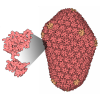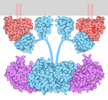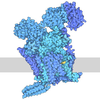+ Open data
Open data
- Basic information
Basic information
| Entry | Database: PDB / ID: 9ebs | ||||||||||||||||||||||||||||||||||||||||||||||||||||||
|---|---|---|---|---|---|---|---|---|---|---|---|---|---|---|---|---|---|---|---|---|---|---|---|---|---|---|---|---|---|---|---|---|---|---|---|---|---|---|---|---|---|---|---|---|---|---|---|---|---|---|---|---|---|---|---|
| Title | Cryo-EM structure of USP1-UAF1-Ubiquitin in complex with TNG348 | ||||||||||||||||||||||||||||||||||||||||||||||||||||||
 Components Components |
| ||||||||||||||||||||||||||||||||||||||||||||||||||||||
 Keywords Keywords | HYDROLASE / deubiquitination / PCNA / allosteric inhibitor | ||||||||||||||||||||||||||||||||||||||||||||||||||||||
| Function / homology |  Function and homology information Function and homology informationregulation of protein monoubiquitination / positive regulation of error-prone translesion synthesis / Signaling by cytosolic PDGFRA and PDGFRB fusion proteins / monoubiquitinated protein deubiquitination / deubiquitinase activator activity / hypothalamus gonadotrophin-releasing hormone neuron development / female meiosis I / positive regulation of protein monoubiquitination / fat pad development / skeletal system morphogenesis ...regulation of protein monoubiquitination / positive regulation of error-prone translesion synthesis / Signaling by cytosolic PDGFRA and PDGFRB fusion proteins / monoubiquitinated protein deubiquitination / deubiquitinase activator activity / hypothalamus gonadotrophin-releasing hormone neuron development / female meiosis I / positive regulation of protein monoubiquitination / fat pad development / skeletal system morphogenesis / mitochondrion transport along microtubule / skin development / female gonad development / seminiferous tubule development / male meiosis I / positive regulation of intrinsic apoptotic signaling pathway by p53 class mediator / homeostasis of number of cells / protein deubiquitination / embryonic organ development / single fertilization / regulation of DNA repair / response to UV / positive regulation of double-strand break repair via homologous recombination / energy homeostasis / regulation of neuron apoptotic process / neuron projection morphogenesis / regulation of proteasomal protein catabolic process / Maturation of protein E / Maturation of protein E / ER Quality Control Compartment (ERQC) / Myoclonic epilepsy of Lafora / FLT3 signaling by CBL mutants / Prevention of phagosomal-lysosomal fusion / IRAK2 mediated activation of TAK1 complex / Alpha-protein kinase 1 signaling pathway / Glycogen synthesis / IRAK1 recruits IKK complex / IRAK1 recruits IKK complex upon TLR7/8 or 9 stimulation / Endosomal Sorting Complex Required For Transport (ESCRT) / Membrane binding and targetting of GAG proteins / Negative regulation of FLT3 / Regulation of TBK1, IKKε (IKBKE)-mediated activation of IRF3, IRF7 / PTK6 Regulates RTKs and Their Effectors AKT1 and DOK1 / Regulation of TBK1, IKKε-mediated activation of IRF3, IRF7 upon TLR3 ligation / Constitutive Signaling by NOTCH1 HD Domain Mutants / IRAK2 mediated activation of TAK1 complex upon TLR7/8 or 9 stimulation / NOTCH2 Activation and Transmission of Signal to the Nucleus / TICAM1,TRAF6-dependent induction of TAK1 complex / TICAM1-dependent activation of IRF3/IRF7 / APC/C:Cdc20 mediated degradation of Cyclin B / Downregulation of ERBB4 signaling / Regulation of FZD by ubiquitination / APC-Cdc20 mediated degradation of Nek2A / p75NTR recruits signalling complexes / InlA-mediated entry of Listeria monocytogenes into host cells / TRAF6 mediated IRF7 activation in TLR7/8 or 9 signaling / TRAF6-mediated induction of TAK1 complex within TLR4 complex / Regulation of pyruvate metabolism / NF-kB is activated and signals survival / Regulation of innate immune responses to cytosolic DNA / Downregulation of ERBB2:ERBB3 signaling / Pexophagy / NRIF signals cell death from the nucleus / VLDLR internalisation and degradation / Regulation of PTEN localization / Activated NOTCH1 Transmits Signal to the Nucleus / Regulation of BACH1 activity / Synthesis of active ubiquitin: roles of E1 and E2 enzymes / MAP3K8 (TPL2)-dependent MAPK1/3 activation / Translesion synthesis by REV1 / TICAM1, RIP1-mediated IKK complex recruitment / InlB-mediated entry of Listeria monocytogenes into host cell / Translesion synthesis by POLK / Activation of IRF3, IRF7 mediated by TBK1, IKKε (IKBKE) / Downregulation of TGF-beta receptor signaling / JNK (c-Jun kinases) phosphorylation and activation mediated by activated human TAK1 / Josephin domain DUBs / Translesion synthesis by POLI / Regulation of activated PAK-2p34 by proteasome mediated degradation / Gap-filling DNA repair synthesis and ligation in GG-NER / IKK complex recruitment mediated by RIP1 / ubiquitin binding / positive regulation of protein ubiquitination / positive regulation of epithelial cell proliferation / PINK1-PRKN Mediated Mitophagy / TGF-beta receptor signaling in EMT (epithelial to mesenchymal transition) / TNFR1-induced NF-kappa-B signaling pathway / Autodegradation of Cdh1 by Cdh1:APC/C / skeletal system development / regulation of mitochondrial membrane potential / APC/C:Cdc20 mediated degradation of Securin / TCF dependent signaling in response to WNT / N-glycan trimming in the ER and Calnexin/Calreticulin cycle / Regulation of NF-kappa B signaling / Asymmetric localization of PCP proteins / Ubiquitin-dependent degradation of Cyclin D / activated TAK1 mediates p38 MAPK activation / SCF-beta-TrCP mediated degradation of Emi1 / NIK-->noncanonical NF-kB signaling / TNFR2 non-canonical NF-kB pathway Similarity search - Function | ||||||||||||||||||||||||||||||||||||||||||||||||||||||
| Biological species |  Homo sapiens (human) Homo sapiens (human) | ||||||||||||||||||||||||||||||||||||||||||||||||||||||
| Method | ELECTRON MICROSCOPY / single particle reconstruction / cryo EM / Resolution: 3.3 Å | ||||||||||||||||||||||||||||||||||||||||||||||||||||||
 Authors Authors | Whittington, D.A. | ||||||||||||||||||||||||||||||||||||||||||||||||||||||
| Funding support |  United States, 1items United States, 1items
| ||||||||||||||||||||||||||||||||||||||||||||||||||||||
 Citation Citation |  Journal: Mol Cancer Ther / Year: 2025 Journal: Mol Cancer Ther / Year: 2025Title: Characterization of TNG348: A Selective, Allosteric USP1 Inhibitor That Synergizes with PARP Inhibitors in Tumors with Homologous Recombination Deficiency. Authors: Antoine Simoneau / Charlotte B Pratt / Hsin-Jung Wu / Shreya S Rajeswaran / Charlotte Grace Comer / Sirimas Sudsakorn / Wenhai Zhang / Shangtao Liu / Samuel R Meier / Ashley H Choi / Tenzing ...Authors: Antoine Simoneau / Charlotte B Pratt / Hsin-Jung Wu / Shreya S Rajeswaran / Charlotte Grace Comer / Sirimas Sudsakorn / Wenhai Zhang / Shangtao Liu / Samuel R Meier / Ashley H Choi / Tenzing Khendu / Hannah Stowe / Binzhang Shen / Douglas A Whittington / Yingnan Chen / Yi Yu / William D Mallender / Tianshu Feng / Jannik N Andersen / John P Maxwell / Scott Throner /  Abstract: Inhibition of the deubiquitinating enzyme USP1 can induce synthetic lethality in tumors characterized by homologous recombination deficiency (HRD) and represents a novel therapeutic strategy for the ...Inhibition of the deubiquitinating enzyme USP1 can induce synthetic lethality in tumors characterized by homologous recombination deficiency (HRD) and represents a novel therapeutic strategy for the treatment of BRCA1/2-mutant cancers, potentially including patients whose tumors have primary or acquired resistance to PARP inhibitors (PARPi). In this study, we present a comprehensive characterization of TNG348, an allosteric, selective, and reversible inhibitor of USP1. TNG348 induces dose-dependent accumulation of ubiquitinated protein substrates both in vitro and in vivo. CRISPR screens show that TNG348 exerts its antitumor effect by disrupting the translesion synthesis pathway of DNA damage tolerance through RAD18-dependent ubiquitinated PCNA. Although TNG348 and PARPi share the ability to selectively kill HRD tumor cells, CRISPR screens reveal that TNG348 and PARPi do so through discrete mechanisms. Particularly, knocking out PARP1 causes resistance to PARPi but sensitizes cells to TNG348 treatment. Consistent with these findings, combination of TNG348 with PARPi leads to synergistic antitumor effects in HRD tumors, resulting in tumor growth inhibition and regression in multiple mouse xenograft tumor models. Importantly, our data on human cancer models further show that the addition of TNG348 to PARPi treatment can overcome acquired PARPi resistance in vivo. Although the clinical development of TNG348 has been discontinued because of unexpected liver toxicity in patients (NCT06065059), the present data provide preclinical and mechanistic support for the continued exploration of USP1 as a drug target for the treatment of patients with BRCA1/2-mutant or HRD cancers. | ||||||||||||||||||||||||||||||||||||||||||||||||||||||
| History |
|
- Structure visualization
Structure visualization
| Structure viewer | Molecule:  Molmil Molmil Jmol/JSmol Jmol/JSmol |
|---|
- Downloads & links
Downloads & links
- Download
Download
| PDBx/mmCIF format |  9ebs.cif.gz 9ebs.cif.gz | 262.8 KB | Display |  PDBx/mmCIF format PDBx/mmCIF format |
|---|---|---|---|---|
| PDB format |  pdb9ebs.ent.gz pdb9ebs.ent.gz | Display |  PDB format PDB format | |
| PDBx/mmJSON format |  9ebs.json.gz 9ebs.json.gz | Tree view |  PDBx/mmJSON format PDBx/mmJSON format | |
| Others |  Other downloads Other downloads |
-Validation report
| Summary document |  9ebs_validation.pdf.gz 9ebs_validation.pdf.gz | 1.4 MB | Display |  wwPDB validaton report wwPDB validaton report |
|---|---|---|---|---|
| Full document |  9ebs_full_validation.pdf.gz 9ebs_full_validation.pdf.gz | 1.5 MB | Display | |
| Data in XML |  9ebs_validation.xml.gz 9ebs_validation.xml.gz | 39 KB | Display | |
| Data in CIF |  9ebs_validation.cif.gz 9ebs_validation.cif.gz | 56.6 KB | Display | |
| Arichive directory |  https://data.pdbj.org/pub/pdb/validation_reports/eb/9ebs https://data.pdbj.org/pub/pdb/validation_reports/eb/9ebs ftp://data.pdbj.org/pub/pdb/validation_reports/eb/9ebs ftp://data.pdbj.org/pub/pdb/validation_reports/eb/9ebs | HTTPS FTP |
-Related structure data
| Related structure data |  47889MC M: map data used to model this data C: citing same article ( |
|---|---|
| Similar structure data | Similarity search - Function & homology  F&H Search F&H Search |
- Links
Links
- Assembly
Assembly
| Deposited unit | 
|
|---|---|
| 1 |
|
- Components
Components
-Protein , 3 types, 3 molecules CDE
| #1: Protein | Mass: 8519.778 Da / Num. of mol.: 1 Source method: isolated from a genetically manipulated source Details: vinyl sulfone modification at C-terminus / Source: (gene. exp.)  Homo sapiens (human) / Gene: UBB / Production host: Homo sapiens (human) / Gene: UBB / Production host:  |
|---|---|
| #2: Protein | Mass: 77309.359 Da / Num. of mol.: 1 Source method: isolated from a genetically manipulated source Details: C-terminal Flag tag / Source: (gene. exp.)  Homo sapiens (human) / Gene: WDR48, KIAA1449, UAF1 / Plasmid: pFastBac1 / Production host: Homo sapiens (human) / Gene: WDR48, KIAA1449, UAF1 / Plasmid: pFastBac1 / Production host:  |
| #3: Protein | Mass: 88406.344 Da / Num. of mol.: 1 / Mutation: G670A,G671A Source method: isolated from a genetically manipulated source Source: (gene. exp.)  Homo sapiens (human) / Gene: USP1 / Plasmid: pFastBac1 / Production host: Homo sapiens (human) / Gene: USP1 / Plasmid: pFastBac1 / Production host:  |
-Non-polymers , 3 types, 3 molecules 
| #4: Chemical | ChemComp-A1A4Y / Mass: 137.201 Da / Num. of mol.: 1 / Source method: obtained synthetically / Formula: C4H11NO2S |
|---|---|
| #5: Chemical | ChemComp-ZN / |
| #6: Chemical | ChemComp-A1BHF / Mass: 603.522 Da / Num. of mol.: 1 / Source method: obtained synthetically / Formula: C27H23F6N9O / Feature type: SUBJECT OF INVESTIGATION |
-Details
| Has ligand of interest | Y |
|---|---|
| Has protein modification | Y |
-Experimental details
-Experiment
| Experiment | Method: ELECTRON MICROSCOPY |
|---|---|
| EM experiment | Aggregation state: PARTICLE / 3D reconstruction method: single particle reconstruction |
- Sample preparation
Sample preparation
| Component | Name: USP1-UAF1-Ub complex with TNG348 / Type: COMPLEX Details: USP1-UAF1 co-expressed and purified; Ub-VS then used to covalently modify USP1 Entity ID: #1-#3 / Source: RECOMBINANT | ||||||||||||||||
|---|---|---|---|---|---|---|---|---|---|---|---|---|---|---|---|---|---|
| Molecular weight | Value: 0.174 MDa / Experimental value: NO | ||||||||||||||||
| Source (natural) | Organism:  Homo sapiens (human) Homo sapiens (human) | ||||||||||||||||
| Source (recombinant) | Organism:  | ||||||||||||||||
| Buffer solution | pH: 7.5 | ||||||||||||||||
| Buffer component |
| ||||||||||||||||
| Specimen | Conc.: 0.2 mg/ml / Embedding applied: NO / Shadowing applied: NO / Staining applied: NO / Vitrification applied: YES | ||||||||||||||||
| Specimen support | Grid material: GOLD | ||||||||||||||||
| Vitrification | Instrument: FEI VITROBOT MARK IV / Cryogen name: ETHANE |
- Electron microscopy imaging
Electron microscopy imaging
| Experimental equipment |  Model: Titan Krios / Image courtesy: FEI Company |
|---|---|
| Microscopy | Model: TFS KRIOS |
| Electron gun | Electron source:  FIELD EMISSION GUN / Accelerating voltage: 300 kV / Illumination mode: FLOOD BEAM FIELD EMISSION GUN / Accelerating voltage: 300 kV / Illumination mode: FLOOD BEAM |
| Electron lens | Mode: BRIGHT FIELD / Nominal defocus max: 2000 nm / Nominal defocus min: 1000 nm |
| Image recording | Average exposure time: 2.5 sec. / Electron dose: 51.3 e/Å2 / Film or detector model: GATAN K3 (6k x 4k) / Num. of real images: 6175 |
| EM imaging optics | Energyfilter name: TFS Selectris X / Energyfilter slit width: 20 eV |
- Processing
Processing
| EM software |
| ||||||||||||||||||||||||||||||||
|---|---|---|---|---|---|---|---|---|---|---|---|---|---|---|---|---|---|---|---|---|---|---|---|---|---|---|---|---|---|---|---|---|---|
| CTF correction | Type: PHASE FLIPPING AND AMPLITUDE CORRECTION | ||||||||||||||||||||||||||||||||
| Particle selection | Num. of particles selected: 3700674 | ||||||||||||||||||||||||||||||||
| 3D reconstruction | Resolution: 3.3 Å / Resolution method: FSC 0.143 CUT-OFF / Num. of particles: 151407 / Symmetry type: POINT | ||||||||||||||||||||||||||||||||
| Atomic model building | Protocol: RIGID BODY FIT / Space: REAL | ||||||||||||||||||||||||||||||||
| Atomic model building | 3D fitting-ID: 1 / Source name: PDB / Type: experimental model
| ||||||||||||||||||||||||||||||||
| Refinement | Cross valid method: NONE Stereochemistry target values: GeoStd + Monomer Library + CDL v1.2 | ||||||||||||||||||||||||||||||||
| Displacement parameters | Biso mean: 73.21 Å2 | ||||||||||||||||||||||||||||||||
| Refine LS restraints |
|
 Movie
Movie Controller
Controller



 PDBj
PDBj



















